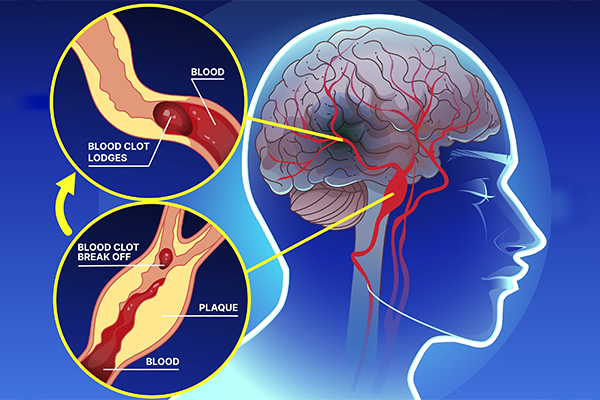
A brain aneurysm is a silent killer; you might not even know you have one until the consequences of it become life-threatening. Recognising brain aneurysm symptoms, brain aneurysm treatment options, and most importantly, understanding the aneurysm is a crucial step to take for yourself and for the people you care about.
In this detailed guide, we explain everything you need to know about brain aneurysms: how they develop, signs that could indicate their presence, and the most effective treatments currently available. Our experienced neurosurgeons in Jaipur play a vital role in diagnosing and managing this complex condition, providing patients with expert care and compassion at every step.
Synopsis
What is a Brain Aneurysm?
A brain aneurysm is a bulge or ballooning in a blood vessel in the brain caused by a weakening of the vessel wall. This abnormal dilation can vary in size and shape, but the most critical risk occurs if the aneurysm ruptures. A ruptured brain aneurysm leads to bleeding in the brain (hemorrhagic stroke), which requires immediate medical attention.
Recognising what a brain aneurysm is sets the foundation for understanding why early detection and intervention are so important. Our neurosurgeons in Jaipur emphasise regular checkups for those with risk factors to prevent severe outcomes.

Common Causes of Brain Aneurysms
Numerous factors can contribute to weakening the artery walls in the brain, resulting in aneurysm formation:
-
High Blood Pressure: Constant pressure can weaken blood vessel walls.
-
Genetic Predisposition: Family history increases the risk of a brain aneurysm.
-
Age and Gender: Middle-aged adults, especially females, are more susceptible.
-
Smoking: Tobacco use damages blood vessels and elevates risk.
-
Trauma and Injury: Previous head injuries may lead to aneurysm development.
-
Infections: Rarely, infections can weaken arterial walls.
-
Other Medical Conditions: Disorders like polycystic kidney disease and connective tissue disorders.
Our team of best neurosurgeons in Jaipur evaluates these risk factors carefully when diagnosing patients, ensuring a tailored approach to brain aneurysm treatment.
Recognising Brain Aneurysm Symptoms Early
One of the challenges with brain aneurysms is their frequent lack of early symptoms. However, when symptoms do appear, they warrant immediate medical evaluation as they could signal an impending rupture or an enlarging aneurysm.
Common brain aneurysm symptoms before rupture include:
-
A sudden, severe headache is often described as the worst headache ever experienced
-
Blurred or double vision
-
Pain above or behind the eye
-
Dilated pupils
-
Weakness or numbness on one side of the body
-
Difficulty speaking
-
Stiff neck or sensitivity to light in some cases
If the aneurysm ruptures, symptoms escalate rapidly and include loss of consciousness, seizures, nausea, vomiting, and sudden neurological deficits.
At our multispecialty hospital in Jaipur, recognising brain aneurysm symptoms early helps initiate urgent treatment to save lives and preserve brain function.
Diagnostic Evaluation: How Brain Aneurysms Are Detected
When a brain aneurysm is suspected based on symptoms or risk factors, the following imaging tools are used to confirm the diagnosis:
-
CT Scan (Computed Tomography): Quickly identifies bleeding in the brain.
-
MRI (Magnetic Resonance Imaging): Provides detailed images of blood vessels and brain tissue.
-
Cerebral Angiography: A minimally invasive procedure that maps blood flow in arteries, considered the gold standard for detecting and evaluating aneurysms.
Our experienced neurosurgeons in Jaipur utilise the latest diagnostic technology to accurately assess the size, shape, and location of brain aneurysms, informing the best brain aneurysm treatment plan.
Brain Aneurysm Treatment Options
The ideal brain aneurysm treatment depends on factors like aneurysm size, location, symptom severity, and patient health.
-
Observation and Monitoring - Small, unruptured aneurysms with low rupture risk may be carefully monitored with periodic imaging. Blood pressure control and lifestyle changes are emphasised.
-
Surgical Clipping - This involves a craniotomy (opening the skull) and placing a clip at the aneurysm’s base to isolate it from blood flow and prevent rupture. This time-tested method is performed by skilled neurosurgeons in Jaipur with precision and care.
-
Endovascular Coiling - A less invasive approach where a catheter is inserted into the groin and navigated to the aneurysm site. Tiny platinum coils are deployed to induce clotting inside the aneurysm, sealing it off.
-
Flow Diversion Devices - These newer devices redirect blood flow away from the aneurysm, promoting healing of the vessel wall. This method is suitable for wide-neck or complex aneurysms.
-
Supportive Care - For ruptured aneurysms, intensive care management includes controlling brain swelling, preventing vasospasm, and managing complications..
-
Managing Recovery and Long-Term Outcomes - Recovery and prognosis after brain aneurysm treatment depend greatly on timely diagnosis and intervention. Patients may need rehabilitation for neurological symptoms and lifestyle adjustments to prevent recurrence.
Our neurosurgeons in Jaipur provide continued care, guiding patients about medication adherence, blood pressure control, and healthy lifestyle habits to maximise brain aneurysm treatment success.
With advances in both surgical and endovascular techniques, many patients enjoy improved outcomes and quality of life post-treatment.
Why Choose Manipal Hospital’s Neurosurgeons in Jaipur for Brain Aneurysm Care?
Brain aneurysm treatment requires not only advanced technology but also experienced surgeons who understand the nuances of vascular brain disorders. Our neurosurgical team of highly in Jaipur combines expert knowledge with personalised care, ensuring each patient receives:
-
A multidisciplinary approach integrating neurology, neurosurgery, and critical care
-
Compassionate support throughout the preoperative, operative, and postoperative phases
-
Access to thorough counselling addressing fears and expectations
Their commitment has made Jaipur a leading centre for brain aneurysm treatment with excellent safety records and patient satisfaction.
FAQ's
An aneurysm in the brain is a protrusion in a brain artery that can rupture and bleed. It is a life-threatening condition that requires immediate medical care upon rupture.
They include a sudden and severe headache, vision difficulties, eye discomfort, one-sided weakness and, in more severe cases, a loss of consciousness due to aneurysm rupture.
A brain aneurysm is diagnosed with CT and MRI scans, which are then followed by cerebral angiography for better visualisation of the blood vessels, allowing for assessment of the aneurysm features.
Treatment may be monitoring for small aneurysms or surgical clipping, endovascular coiling, or flow diversion for larger or symptomatic aneurysms.
Our skilled neurosurgeons in Jaipur have demonstrated their brain aneurysm treatment expertise by achieving remarkable results with advanced technology and compassionate patient care.





















 5 Min Read
5 Min Read
















